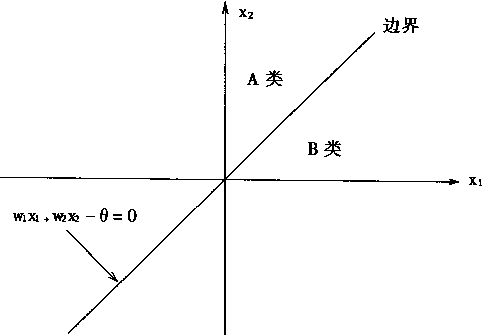版权声明:本文为博主原创文章,未经博主允许不得转载。 https://blog.csdn.net/nealgavin/article/details/27493989
| 感知器学习算法步骤如下:
|
| 图1-10 感知器的分类例子 |
| 2.输入一样本X=(X1 ,X2 ,…,Xn+1 )以及它的期望输出d。 期望输出值d在样本的类属不同时取值不同。如果x是A类,则取d=1,如果x是B类,则取-1。期望输出d也即是教师信号。 3.计算实际输出值Y
4.根据实际输出求误差e e=d-Y(t) (1-21) 5.用误差e去修改权系数
i=1,2,…,n,n+1 (1-22) 其中,η称为权重变化率,0<η≤1 |
# -*- coding: cp936 -*-
import numpy
import pylab
import sys
class neuralNetwork:
b = 1
learnRaito = 0.5
trainData = numpy.array([[b,1,3],[b,2,3],[b,1,8],[b,2,15],[b,3,7],[b,4,29],[b,4,8],[b,4,20]])
#训练数据 可以训练不同的方程 模型
trainResult = numpy.array([1,1,-1,-1,1,-1,1,-1])
weight = numpy.array([b,0,0])
error = 0.001
def Out(self,v):
"""求值的取向"""
if v>=0:
return 1
else:
return -1
def exceptSignal(self,oldw,inx):
#a bug here
#print '-'*20
#print oldw
#print inx
#print numpy.dot(oldw.T,inx)
#print '+'*20
#return 1
ans = numpy.dot(oldw.T,inx)
return self.Out(ans)
def trainOnce(self,oldw,inx,correctResult):
"""one training"""
error = correctResult - self.exceptSignal(oldw,inx)
newWeight = oldw + self.learnRaito*error*inx
self.weight = newWeight
return error
def getAbs(self,x):
if x<0:
return -x
else:
return x
def trainWeight(self):
"""traing the weight of data"""
error = 1
while error > self.error:
i = 0
error = 0
for inx in self.trainData:
error += self.getAbs(self.trainOnce(self.weight,inx,self.trainResult[i]))
i = i+1
def drawTrainResult(self):
""" draw graph of Result"""
xor = self.trainData[:,1]#切片,获取第一列,x坐标
yor = self.trainData[:,2]#切片,获取第二列,y坐标
pylab.subplot(111)
xMax = numpy.max(xor)+15
xMin = numpy.min(xor)-5
yMax = numpy.max(yor)+50
yMin = numpy.min(yor)-5
pylab.xlabel(u'xor')
pylab.ylabel(u'yor')
pylab.xlim(xMin,xMax)
pylab.ylim(yMin,yMax)
#draw point
for i in range(0,len(self.trainResult)):
if self.trainResult[i] == 1:
pylab.plot(xor[i],yor[i],'r*')
else:
pylab.plot(xor[i],yor[i],'ro')
def drawTestResult(self,data):
test = data#numpy.array(data)
if self.exceptSignal(self.weight,test)>0:
pylab.plot(test[1],test[2],'b*')
else:
pylab.plot(test[1],test[2],'bo')
def drawTrueLine(self):
"""真实函数分界线"""
xtest = numpy.array(range(0,20))
ytest = xtest*2+1.68
pylab.plot(xtest,ytest,'g--')
def showGraph(self):
pylab.show()
testData = [[1,5,11],[1,5,12],[1,4,16],[1,6,7],[1,3,12],[1,2,22]]
neural = neuralNetwork()
print neural.Out(124.32423)
neural.trainWeight()
neural.drawTrainResult()
neural.drawTrueLine()
#neural.showGraph()
for test in testData:
neural.drawTestResult(test)
print neural.weight
neural.showGraph()
红色是训练数据,蓝色是测试数据,圆点代表是在线上方,*代表在线下方,由图可知这个算法还不错



